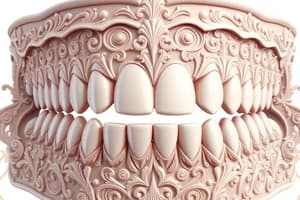Podcast
Questions and Answers
What is the primary purpose of occlusion blocks?
What is the primary purpose of occlusion blocks?
- To establish facial contours (correct)
- To determine tooth color
- To aid in dental hygiene practices
- To enhance patient comfort
What is the minimum uniform thickness required for a record base?
What is the minimum uniform thickness required for a record base?
- 3 mm
- 2 mm (correct)
- 4 mm
- 1 mm
Which material is used as a separating medium during the record base fabrication process?
Which material is used as a separating medium during the record base fabrication process?
- Aluminum foil
- Vaseline
- Tinfoil substitute (correct)
- Liquid paraffin
Which of the following describes a requirement for a trial denture base?
Which of the following describes a requirement for a trial denture base?
What is the purpose of waxing out tissue undercuts and irregularities?
What is the purpose of waxing out tissue undercuts and irregularities?
What is the appropriate width of occlusion rims in the anterior region?
What is the appropriate width of occlusion rims in the anterior region?
When should the cast be soaked in room temperature water during the record base preparation?
When should the cast be soaked in room temperature water during the record base preparation?
How many thin layers of tinfoil substitute should be applied?
How many thin layers of tinfoil substitute should be applied?
Which of the following is NOT a use of occlusion rims?
Which of the following is NOT a use of occlusion rims?
How are the record bases designed in relation to the crest of the ridges?
How are the record bases designed in relation to the crest of the ridges?
What is a characteristic feature of a record base?
What is a characteristic feature of a record base?
What is the vertical height of the mandibular occlusion rim?
What is the vertical height of the mandibular occlusion rim?
What specific feature is determined on the occlusion rim for the arrangement of teeth?
What specific feature is determined on the occlusion rim for the arrangement of teeth?
What is a common misconception regarding record bases and occlusion rims?
What is a common misconception regarding record bases and occlusion rims?
Where is the labial surface of the maxillary occlusion rim positioned in relation to the incisive papilla?
Where is the labial surface of the maxillary occlusion rim positioned in relation to the incisive papilla?
How far should the posterior lower region height of the occlusion rim be from the retromolar pad?
How far should the posterior lower region height of the occlusion rim be from the retromolar pad?
Flashcards are hidden until you start studying
Study Notes
Record Bases and Occlusion Blocks
- Definition: Occlusion blocks consist of occlusion rims attached to well-fitting trial denture bases.
- Functions:
- Establish facial contours
- Aid in tooth selection
- Establish and maintain vertical dimension of occlusion during record making
- Make interocclusal records
- Arrange denture teeth
- Waxed-up mold for the external surface of the complete denture
Requirements of a Trial Denture Base
- Characteristics:
- Rigid
- Accurately adapted to the cast with proper extensions
- Dimensionally stable with minimal warpage
- Relieved from any undercuts to avoid scraping the cast during insertion and removal
- Clean and smooth for patient comfort
- Proper and uniform thickness (2mm)
- Easy to construct
Wax Block Out
- Purpose: Protect master casts, tissue undercuts and irregularities are blocked out with base plate wax.
- Locations:
- Maxillary casts: Labial of the anterior ridge, rugae areas, sometimes in the tuberosity areas laterally.
- Mandibular cast: Retromylohyoid areas.
Record Base Fabrication Procedure
- Soak Cast: The cast is soaked in room temperature water for 5 minutes to expel air and minimize defects.
- Separating Medium: A tinfoil substitute is used as a separating medium to protect the cast and allow separation of the record base.
- Tinfoil Substitute Application: It is applied twice, allowing the first layer to dry before applying the second. A thin film is applied to all surfaces of the cast including land areas.
- Record Base Material: Autopolymerizing acrylic resin is used to fabricate the record base.
- Record Base Thickness: Thinner on the crest of the ridges and buccal to the crest of the ridges because space may be limited for tooth arrangement.
Occlusion Rim Fabrication
- Material: Occlusion rims are generally made of pink modeling wax.
- Functions:
- Registration of jaw relationships
- Choice of artificial teeth:
- Midline is determined
- High and low lip lines are determined to indicate tooth length
- Canine lines indicate tooth width
- Distance between canine line and posterior end of occlusion rim determines the mesiodistal (M-D) width of posterior teeth
- Setting-up of teeth
- Support for lip and cheeks
Occlusion Rim Dimensions
- Width:
- Approximately 8-10 mm in width posteriorly.
- 6-8 mm in width anteriorly.
- Maxillary Occlusion Rim Vertical Height: The labial surface in the central area is approximately 6-8 mm anterior to the middle of the incisive papilla and is inclined labially
- Mandibular Occlusion Rim Vertical Height: About 18mm.
- In the posterior lower region, the height is equal to two-thirds the height of the retromolar pad (middle to upper third).
Important Patient Considerations
- Information: Patients should be informed that the record bases and occlusion rims are not part of the completed dentures. They may feel a little loose due to the blocked-out undercuts.
References
- Rahn, A.O., Heartwell, C.M. (1993). Textbook of complete dentures. (5th ed.). Philadelphia: Lea & Febiger.
- Sowter, J.B. (1986). Baseplates. In R.E. Barton (Ed.), Removable Prosthodontic Techniques (Revised edition). Chapel Hill: University of North Carolina Press.
- Zarb, G.A., Bolander, C.L. (2004). Prosthodontic treatment for edentulous patients. (12th ed.). St. Louis: Mosby Inc.
Studying That Suits You
Use AI to generate personalized quizzes and flashcards to suit your learning preferences.




